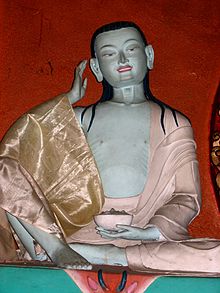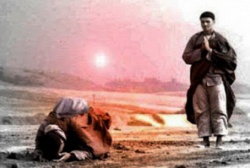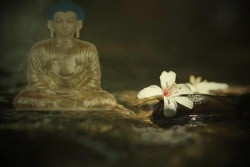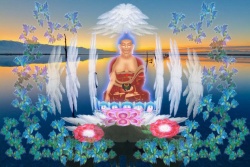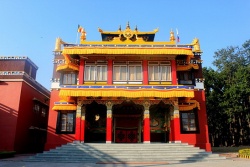Elephant
Click here to see other articles relating to word Elephant
The Indian Elephant goes back to the mythologies. As the Gods ( ‘Deva’) and the demons ( ‘Asura’) churned the oceans during ‘sagar manthan’ ( sagar = sea ; manthan = churning ) for the elixir of life - ‘amrit’ ( nectar ) that would make them immortal ,
there surfaced the ‘navratnas’ ( nine jewels ). One of these jewels was the elephant.
The elephant is, therefore, considered absolutely precious to be preserved and protected like the way jewels are. (e/1)
There are other mythological stories. For example, in one of her dreams, Buddha’s mother dreamt of a white elephant. And then the prophet of peace Gautam Buddha was born. Obviously, therefore, a white elephant in India’s cultural context can never connotate redundancy, as it would in the West. (e/2)
And then comes the greatest of all ‘vahanas’ (carriages for Gods) - the ‘Airavat’ ( elephant ).
The Airavat was the chosen carriage for the God of all Gods ‘ Indra ’. There were other Gods as well riding on elephants as well, but Indra’s airavat was special. It was regal in size and had ten tusks, not just the usual two.
In the epic Mahabharata, there is the legendary story about an elephant named ‘Ashvatthama’, who carried the same name as the son of the revered teacher for both the warring families of the Pandavas and the Kauravas.
At the battle of all battles Kurukshetra, fought between these two families, an innocuous lie in the middle of the battlefield announcing that Ashvatthama was dead,
was actually meant to upset the Kauravas by giving out the impression that the teacher’s son was dead where, in fact, it was the elephant that had got killed. However, this strategic piece of lie had had the exact desired effect of lowering the enemy’s guards.
And a lie that has since come to be disapproved of.
In Indian temple architecture, the elephant has contributed to an important concept called the ‘Gajthar’ ( gaj = elephant ; thar = base ).
It simply represents the lowest slab of the entire construction spectrum made up of the element of the square at the base and overlain by the elements of the circle, the triangle, the crescent and the dot respectively.
It is commonplace to find the elephant symbolically replacing the square so that the temple appears to be upheld by sculpted elephants.
The point here being that the elephant is considered an epitome of strength, adequate enough to uphold the weight of a stone temple.
The symbology of the elephant extends into the domain of the sacred, with the ‘Ganesh’ ( Indian God with human body and elephant head ) being worshipped as a sign of welbeing, prosperity as well as a mover of good things and events. Inspite of these mighty attributes, Ganesh ( ‘gan’ = common man ; ‘ish’ = god ) is more loved than feared by the common man. .
The elephant is so majestic that it has been considered as a vehicle for kings. When Alexander the Great invaded India in 325 B.C. , he came to realise the symbolic might of the elephant.
As he battled with King Porus ( King Puru from his actual name Purushottam = the noblest of all men ) and defeated him, Alexander himself faced a defeat of his own. This was as he encoutered Porus the person.
There are many stories. One of them is where Porus’ elephant displays his compassion for his master. At the famous battle of Hydaspes in July 326 B.C. , where Porus faced defeat from Alexander) and injury from the numerous arrows, it was his elephant who saved his life.
First, by leaving the battlefield away from the surge of these arrows into relative safety, and then gently lowering the King on the ground so as not to cause him further pain.
And thereafter, carefully dislodging the hurtful arrows from his master’s body. In the same context of the story of the King and Elephant arrives a rare tribute paid to Porus and his elephant.
While it is inconceivable that a conqueror should return to his land and actually commemorate the glories of a king who has just been defeated, Alexander ended up doing just that.
He was so overcome by Porus’ nobleness and greatness as a man that he cast a coin showing King Porus and his elephant alongside himself and his horse - only Porus and his elephant being shown in a size much bigger than his own.
The actual coin can be viewed at the British Museum.
Along the historical path arrived other kings - of both Hindu and Mughal origin who would embrace the elephant as their chosen carriage.
On occasions when they set out as monarchs to survey their kingdoms, they would actually set aside their horses and mount atop the backs of their elephants, which would seem spacious enough to accomodate even an elaborately decorated throne.
The elephant would be the inevitable choice because its height but also its gait, which was slow and regal.
Further, it afforded the king’s subjects to get a clear view of the ruler astride his elephant, and all the pomp and pagaentry that accompanied such a rare occasion.(e/12 c)
This is a famous miniature from the Akbar-nama of Abul Fazal which is a commentary of Mughal king Akbar’s reign ( 1595 A.D.).
The miniature is just one of the innumerable depictions in Indian art and architecture on the use of elephants in wars. .
The elephant in its majesticity continues to hold sway in contemporary Indian life.
Come every January end Kerala lush with its rain forests along India’s south-western coastline, hosts The Great Elephant March which takes after the centuries’ old tradition of the ‘Pooram’ which in Malayalam means temple festival ( Malayalam is the language spoken in Kerala ).
Here in God’s Own Country which is Kerala, hundreds of caparisoned ( bedecked ) tuskers are gathered in horizontal procession, each elephant in regalia displaying its own coloured umbrella as a flagship of the temple to which it belongs.
This dialogue between the elephants is mediated through the ‘mahouts’ ( in Hindi ) or ‘aanakkaran’ in Malayalam ( aanai = elephant, karan = caretaker ); and who are the elephants’ riders and caretakers.
They hold the supreme confidence of the elephant to the point where on the rare occasion that an elephant should erupt in rage, it is the mahout who is called upon to pacify the animal. .

